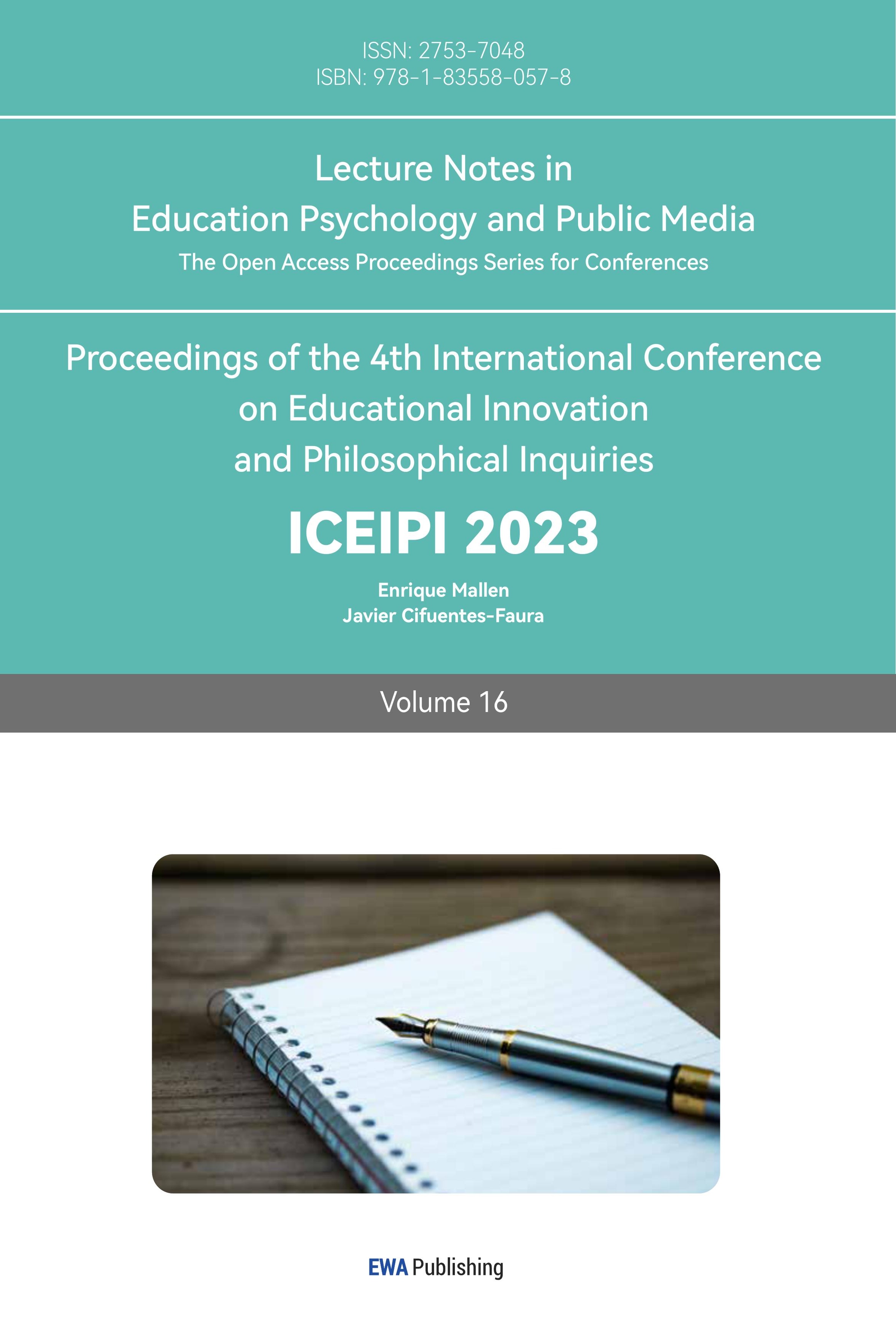References
[1]. “Bloom’s Taxonomy of Cognitive Learning Objectives.” Journal of the Medical Library Association, vol. 103, no. 3, University Library System, University of Pittsburgh, July 2015, pp. 152–53.
[2]. Chen, A., & Guo, S. L. (2021). The Spread of Montessori Education in Mainland China. Journal of Montessori Research and Education, 3(1), 1+.
[3]. Lillard, A. S. (2019). Shunned and Admired: Montessori, Self-Determination, and a Case for Radical School Reform. Educational Psychology Review, 31(4), 939+.
[4]. Lopata, C., Wallace, N. V., & Finn, K. V. (2005). Comparison of academic achievement between Montessori and traditional education programs. Journal of Research in Childhood Education, 20(1), 5+.
[5]. Winnie Cheptoo Kamakil & Herbert Utz Verlag (2013), Play and Creative Drawing in Preschool: A Comparative Study of Montessori and Public Preschools in Kenya.
[6]. Maria Montessori, The Montessori Method——Scientific Pedagogy as Applied to Child Education in ‘The Children’s Houses’ with Additions and Revisions by the Author, New York, FREDERICK A. STOKES COMPANY, 168-171, 2012.
[7]. Xiying Lu (2022), An investigation of effective methods of using Montessori mathematics teaching aids to develop the quality of young children’s thinking.
[8]. Eugenia G Gkeka, Αthanasia Gougoudi, Louisa Mertsioti, Athanasios S Drigas (2018) Intervention for ADHD Child using the Montessori Method and ICTs.
[9]. Haines, Annette, “Montessori: Now More Than Ever.” Montessori Australia Foundation eArticle Issue 1, 1-3, 2007.
[10]. LAI Xiaoqian, The Problems and Solutions of Montessori’s Education in China, Textbook Guide, 2016(17):7-8. DOI:10.16400/j.cnki.kjdkz.2016.06.004.
Cite this article
Liu,S.;Tian,A. (2023). The Influence of Montessori Education on Children's Personality Development and the Way of Thinking. Lecture Notes in Education Psychology and Public Media,16,173-180.
Data availability
The datasets used and/or analyzed during the current study will be available from the authors upon reasonable request.
Disclaimer/Publisher's Note
The statements, opinions and data contained in all publications are solely those of the individual author(s) and contributor(s) and not of EWA Publishing and/or the editor(s). EWA Publishing and/or the editor(s) disclaim responsibility for any injury to people or property resulting from any ideas, methods, instructions or products referred to in the content.
About volume
Volume title: Proceedings of the 4th International Conference on Educational Innovation and Philosophical Inquiries
© 2024 by the author(s). Licensee EWA Publishing, Oxford, UK. This article is an open access article distributed under the terms and
conditions of the Creative Commons Attribution (CC BY) license. Authors who
publish this series agree to the following terms:
1. Authors retain copyright and grant the series right of first publication with the work simultaneously licensed under a Creative Commons
Attribution License that allows others to share the work with an acknowledgment of the work's authorship and initial publication in this
series.
2. Authors are able to enter into separate, additional contractual arrangements for the non-exclusive distribution of the series's published
version of the work (e.g., post it to an institutional repository or publish it in a book), with an acknowledgment of its initial
publication in this series.
3. Authors are permitted and encouraged to post their work online (e.g., in institutional repositories or on their website) prior to and
during the submission process, as it can lead to productive exchanges, as well as earlier and greater citation of published work (See
Open access policy for details).
References
[1]. “Bloom’s Taxonomy of Cognitive Learning Objectives.” Journal of the Medical Library Association, vol. 103, no. 3, University Library System, University of Pittsburgh, July 2015, pp. 152–53.
[2]. Chen, A., & Guo, S. L. (2021). The Spread of Montessori Education in Mainland China. Journal of Montessori Research and Education, 3(1), 1+.
[3]. Lillard, A. S. (2019). Shunned and Admired: Montessori, Self-Determination, and a Case for Radical School Reform. Educational Psychology Review, 31(4), 939+.
[4]. Lopata, C., Wallace, N. V., & Finn, K. V. (2005). Comparison of academic achievement between Montessori and traditional education programs. Journal of Research in Childhood Education, 20(1), 5+.
[5]. Winnie Cheptoo Kamakil & Herbert Utz Verlag (2013), Play and Creative Drawing in Preschool: A Comparative Study of Montessori and Public Preschools in Kenya.
[6]. Maria Montessori, The Montessori Method——Scientific Pedagogy as Applied to Child Education in ‘The Children’s Houses’ with Additions and Revisions by the Author, New York, FREDERICK A. STOKES COMPANY, 168-171, 2012.
[7]. Xiying Lu (2022), An investigation of effective methods of using Montessori mathematics teaching aids to develop the quality of young children’s thinking.
[8]. Eugenia G Gkeka, Αthanasia Gougoudi, Louisa Mertsioti, Athanasios S Drigas (2018) Intervention for ADHD Child using the Montessori Method and ICTs.
[9]. Haines, Annette, “Montessori: Now More Than Ever.” Montessori Australia Foundation eArticle Issue 1, 1-3, 2007.
[10]. LAI Xiaoqian, The Problems and Solutions of Montessori’s Education in China, Textbook Guide, 2016(17):7-8. DOI:10.16400/j.cnki.kjdkz.2016.06.004.









